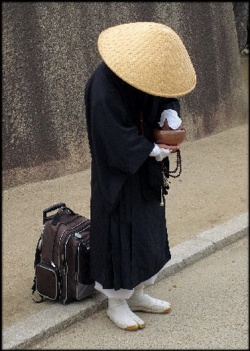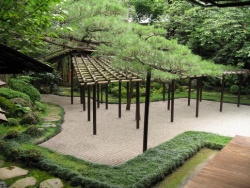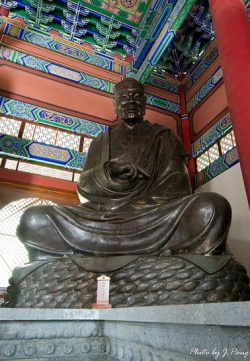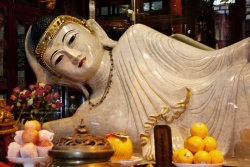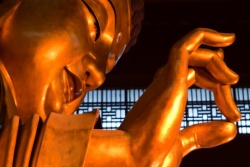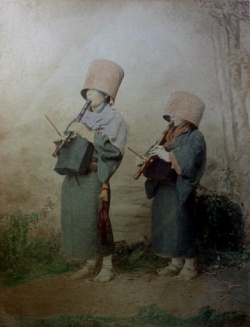Buddhist texts
Buddhist texts can be categorized in a number of ways. The Western terms "scripture" and "canonical" are applied to Buddhism in inconsistent ways by Western scholars: for example, one authority refers to "scriptures and other canonical texts", while another says that scriptures can be categorized into canonical, commentarial and pseudo-canonical. A rather more definite division is that between Buddhavacana (the Word of The Buddha) and other texts.
Buddhavacana
- See also :
- See also :
Traditional criteria
According to Donald Lopez, criteria for determining what should be considered buddhavacana was developed at an early stage, and that the early formulations do not suggest that the Dharma is limited to what was spoken by the historical Buddha. The Mahāsāṃghika and the Mūlasarvāstivāda considered both The Buddha's discourses, as well those of The Buddha's disciples, to be buddhavacana. A number of different beings such as Buddhas, disciples of The Buddha, ṛṣis, and devas were considered capable to transmitting buddhavacana. The content of such a discourse was then to be collated with the sūtras, compared with the Vinaya, and evaluated against the nature of the Dharma. These texts may then be certified as true buddhavacana by a Buddha, a Saṃgha, a small group of elders, or one knowledgeable elder.
In Theravada Buddhism
In Theravada Buddhism, the standard collection of buddhavacana is the Pali Canon.
Some scholars believe that some portions of the Pali Canon and Agamas could contain the actual substance of the historical teachings (and possibly even the words) of The Buddha.
In East Asian Buddhism
In East Asian Buddhism, what is considered buddhavacana is collected in the Chinese Buddhist canon. The most common edition of this is the Taishō Tripiṭaka.
According to Venerable Hsuan Hua from the tradition of Chinese Buddhism, there are five types of beings who may speak the sutras of Buddhism: a Buddha, a disciple of a Buddha, a Deva, a ṛṣi, or an emanation of one of these beings; however, they must first receive certification from a Buddha that its contents are true Dharma. Then these sutras may be properly regarded as buddhavacana.
Sometimes texts that are considered commentaries by some are regarded by others as Buddhavacana.
Shingon Buddhism developed a system that assigned authorship of the early sutras to Gautama Buddha in his physical manifestation, of the Ekayana sutras to the Buddhas as Sambhoghakaya, and the Vajrayana texts to The Buddha as Dharmakaya.
In Tibetan Buddhism
In Tibetan Buddhism, what is considered buddhavacana is collected in the Kangyur. The East Asian and Tibetan Buddhist canons always combined Buddhavacana with other literature in their standard collected editions. However, the general view of what is and is not buddhavacana is broadly similar between East Asian Buddhism and Tibetan Buddhism. The Tibetan Kangyur, which belongs to the various schools of Tibetan Vajrayana Buddhism, in addition to containing sutras and Vinaya, also contains tantras.
Textual traditions
Mahayana sutras are traditionally considered by Mahayanists to be the word of The Buddha, but transmitted either in secret, via lineages of supernatural beings (such as the Nagas), or revealed directly from other Buddhas or bodhisattvas. Some 600 Mahayana Sutras have survived in Sanskrit, or in Chinese and/or Tibetan translation.
The division of texts into the traditional three yanas may obscure the process of development that went on, and there is some overlap in the traditional classifications. For instance, there are so-called proto-Mahayana texts, such as the Ajitasena Sutra, which are missing key features that are associated with Mahayana texts. Some Pali texts also contain ideas that later became synonymous with the Mahayana. The Garbhāvakrānti Sūtra is included in both the Vinaya Pitaka of the Mulasarvastivada, one of the early schools, and the Ratnakuta, a standard collection of Mahayana sutras. Some Mahayana texts are also thought to display a distinctly tantric character, particularly some of the shorter Perfection of Wisdom Sutras. An early tantra, the Mahavairocana Abhisambodhi Tantra, is also known as the Mahavairocana Sutra. At least some editions of the Kangyur include The Heart Sutra in the tantra division. Such overlap is not confined to "neighbouring" yanas: at least nine "Sravakayana" ("Hinayana") texts can be found in the tantra divisions of some editions of the Kangyur. One of them, the Atanatiya Sutra, is also included in the Mikkyo (esoteric) division of the standard modern collected edition of Sino-Japanese Buddhist literature. (A variant of it is also found in the Digha Nikaya of the Pali Canon.)
Some Buddhist texts evolved to become a virtual canon in themselves, and are referred to as vaipulya or extensive sutras. Scholars think, for instance, that the Golden Light Sutra constellated around the celebrated third chapter. The Avatamsaka Sutra is another example of a single Sutra made up of many other sutras, many of which, particularly the Gandavyuha Sutra still circulate as separate texts. The Avatamsaka Sutra and the White Lotus Sutra are associated with the idea of the Ekayana or One Vehicle. The texts claim to unify all the teachings that have come before into a greater whole.
Recently an important archaeological discovery was made, consisting of the earliest known Buddhist manuscripts, recovered from the ancient civilization of Gandhara in north central Pakistan (near Taxila just south west of the capital Islamabad). These fragments, written on birch bark, are dated to the 1st century and have been compared to the Dead Sea scrolls in importance. Donated to the British Library in 1994, they are now being studied in a joint project at the University of Washington.
Other texts have been important from very early in Buddhism. Extensive commentaries exist in Pali for the Pali Canon and in Tibetan, Chinese, Korean and other East Asian languages.
Important examples of non-canonical texts are the Visuddhimagga, or Path of Purification, by Buddhaghosa, which is a compendium of Theravada teachings that include quotes from the Pali Canon. The Milinda Pañha or Questions of Milinda, sometimes included in the Pali Canon and perhaps regarded by some as Buddhavacana, is a popular condensation of the Dharma in the form of a dialogue between the Buddhist sage Nāgasena and the Indo-Greek King Menander.
The treatise Awakening of Faith in the Mahayana (attributed by the faithful to Aśvaghoşa) strongly influenced east Asian Mahayana Doctrine and inspired numerous commentaries authored by early Korean and Chinese Buddhist teachers. Shantideva's Bodhicaryavatara has been influential in both Mahayana and Vajrayana, and his Shikshasamucaya contains references to texts that no longer exist in other forms.
The Platform Sutra attributed to Huineng is on the borders of Buddhavacana; it is one of a very few texts not thought to be spoken by The Buddha that has the label "Sutra." One should note, however, that this distinction may be an artifact of translation; in the original Chinese, the Platform Sutra is a jīng (經), a term that may be translated as "Sutra", but is also applied to a variety of other classic texts, such as the Daodejing and the Shi Jing. In the Platform Sutra, Hui Neng gives an autobiographical account of his succession as Zen Patriarch, as well as teachings about Zen theory and practice. The Zen and Ch'an school in particular rely on non-canonical accounts of Zen masters lives and teachings, for example the Blue Cliff Record.
Tibetan Buddhism has a unique and special class of texts called Terma (Tibetan gTer-ma). These are texts (or ritual objects, etc.) believed either composed or hidden by tantric masters and/or elementally secreted or encoded in the elements and retrieved, accessed or rediscovered by other tantric masters when appropriate. Termas are discovered by a Tertön (Tibetan gTer-stons), whose special function is to discover these texts. Some termas are hidden in Caves or similar places, but a few are said to be 'mind termas,' which are 'discovered' in the mind of the Tertön. The Nyingma school (and Bön tradition) has a large Terma literature. Many of the Terma texts are said to have been written by Padmasambhava, who is particularly important to the Nyingmas. Probably the best known Terma text is the so-called "Tibetan Book of the Dead", the Bardo thodol.
Other types of texts that have been important are the histories of Buddhism in Sri Lanka, the Dipavamsa and Mahavamsa.
Texts of the Early schools
Although many versions of the texts of the early Buddhist schools exist, the most complete canon to survive is the Pali Canon of the Theravadin school, which preserved the texts in the Pali Language. Also large parts of the Sarvastivada and Dharmaguptaka texts are extant.
The Pali literature has been divided by one scholar into roughly three periods. The early, or classical, period begins with the Pali Canon itself and ends with the Milindha-pañha about the turn of the Christian era. After a period of being in comparative disuse or decline, Pali underwent a renaissance in the 4th or 5th century with the help of Buddhaghosa, and this period lasted until the 12th Century. The third period coincides with major political changes in Burma and lasted for some time in Sri Lanka, and much longer in Burma. See also Pali literature.
The other (parts of) extant versions of the Tipitakas of early schools include the agamas, which includes texts of the Sarvastivada and the Dharmaguptaka. Parts of the what is likely to be the canon of the Dharmaguptaka can be found amongst the Gandharan Buddhist Texts. Several early Vinaya Pitakas (from various schools) are also kept in the Chinese (Mahayana) Canon.
Vinaya
The Vinaya literature is primarily concerned with aspects of the monastic discipline. However, Vinaya as a term is also contrasted with Dharma, where the pair (Dhamma-Vinaya) mean something like 'Doctrine and discipline'. The Vinaya literature in fact contains a considerable range of texts. There are, of course, those that discuss the monastic rules, how they came about, how they developed, and how they were applied. But the Vinaya also contains some doctrinal expositions, ritual and liturgical texts, biographical stories, and some elements of the "Jatakas", or birth stories.
Paradoxically, the text most closely associated with the Vinaya, and the most frequently used portion of it, the Pratimoksha, is in itself not a canonical text in Theravada, even though almost all of it can be found in the canon.
Six complete vinayas survive:
- Theravada, written in Pali
- Mula-Sarvāstivāda, written in Sanskrit, but surviving complete only in Tibetan translation
- Mahāsānghika, Sarvāstivāda, Mahīshāsika, and Dharmagupta, originally in Indian languages, but only surviving in Chinese translation.
In addition, portions survive of a number of vinayas in various languages.
The Mahāvastu compiled by the Lokottaravadin sub-school of the Mahāsānghika was perhaps originally the preamble to their Vinaya that became detached; hence, rather than dealing with the rules themselves, it takes the form of an extended biography of The Buddha, which it describes in terms of his progression through Ten bhumis, or stages. This Doctrine was later taken up by the Mahayana in a modified form as Vasubandhu's Ten Stages Sutra.
Sutra
The Sutras (Sanskrit; Pali Sutta) are mostly discourses attributed to The Buddha or one of his close disciples. They are all, even those not actually spoken by him, considered to be Buddhavacana, the word of The Buddha, just as in the case of all canonical literature. The Buddha's discourses were perhaps originally organised according to the style in which they were delivered. There were originally nine, but later twelve, of these. The Sanskrit forms are:
- Sūtra: prose discourses, especially short declarative discourses.
- Geya: mixed prose and verse discourse. Identified with the Sagāthāvagga of the Saṁyutta Nikāya
- Vyākarana: explanation, analysis. Discourses in question and answer format.
- Gāthā: verse
- Udāna: inspired speech
- Ityukta: beginning with 'thus has the Bhagavan said'
- Jātaka: story of previous life
- Abhutadharma: concerning wonders and miraculous events
- Vaipulya either 'extended discourses' or 'those giving joy' (cf Mahayana Texts)
- Nidāna: in which the teachings are set within their circumstances of origin
- Avadāna: tales of exploits
- Upadesha: defined and considered instructions
The first nine are listed in all surviving agamas, with the other three added in some later sources. In Theravada, at least, they are regarded as a classification of the whole of the scriptures, not just suttas. The scheme is also found in Mahayana texts. However, some time later a new organizational scheme was imposed on the canon, which is now the most familiar. The scheme organises the suttas into:
Long discourses
These range in length up to 95 pages. The Pali Digha Nikaya contains 34 texts, including the Mahāparinibbāna Sutta and the Brahmajāla Sutta. The Dīrghāgama of the Dharmagupta also survives, in Chinese translation, and contains 30 sutras.
Medium-length discourses
These are the rest of the sutras of any length, and the Pali Majjhima Nikaya has 152 suttas. The Madhyamāgama of the Sarvāstivada containing 222 sutras survives in Chinese translation.
Connected discourses
This grouping consists of many short texts connected by theme, setting, or interlocutor. The Pali Samyutta Nikaya contains more than 2,800 suttas. The Samyuktāgama of the Sarvāstivada containing only 1,300 sutras survives in Chinese translation.
Numbered discourses
Sutras with the same number of doctrinal items, comprise over 2,300 suttas in the Pali Anguttara Nikaya. The Chinese canon contains an Ekottarāgama that some scholars think belongs to the Mahāsanghika school.
Miscellaneous texts
Not all schools had this category, but the Pali Khuddaka Nikaya has several well-known and loved texts, including:
- The Dhammapada: a collection of sayings and aphorisms.
- The Udana : a collection of inspired sayings in verse usually with a prose introduction that sets a context of sorts for the saying.
- The Sutta Nipata: parts of the Sutta Nipata, such as the Aṭṭhakavagga and the Pārāyanavagga, are thought by some scholars to represent the earliest strata of the written canon. Many of the features of later texts, such as numbered lists of teachings, or complex doctrinal categories, are not present.
- Theragāthā and Therīgāthā two collections of biographical verse related to the disciples of the Buddha.
- Jataka: poems related to the so-called 'birth stories,' which recount former lives of the Buddha. These remain popular in many forms of Buddhism.
Many of these texts are available in translation as well as in the original Language. The Dhammapada, for instance, has a Pali version, three Chinese versions, a Tibetan version, and a Khotanese version.
Abhidharma
Abhidharma (in Pali, Abhidhamma) means 'further Dharma' and is concerned with the analysis of phenomena. It grew initially out of various lists of teachings such as the 37 Bodhipaksika-dharmas or the 37 Factors leading to Awakening. The Abhidharma literature is chiefly concerned with the analysis of phenomena and the relationships between them.
The Theravāda Abhidhamma survives in the Pali Canon. Outside of the Theravada monasteries the Pali Abhidharma texts are not well known.
A Sarvastivada Abhidharma, composed in Sanskrit, survives in Chinese and Tibetan traditions. Though the Theravādin Abhidhamma is well preserved and best known, it should be noted that a number of the early Eighteen Schools each had their own distinct Abhidharma collection with not very much common textual material, though sharing methodology.
Not all schools accepted the Abhidharma as canonical. The Sautrāntika, for instance, held that the canon stopped with the Vinaya and sutras. The rejection by some schools that dharmas (i.e. phenomena) are ultimately real, which the Theravada Abhidhamma, for instance, insists, is thought to be an important factor in the origin of the Mahayana.
Other texts
One early text not usually regarded as Buddhavacana is probably the Milinda pañha (literally The Questions of Milinda). This text is in the form of a dialogue between Nagasena, and the Indo-Greek King Menander (Pali: Milinda). It is a compendium of Doctrine, and covers a range of subjects. It is included in some editions of the Pali Canon.
The Pali texts have an extensive commentarial literature much of which is still untranslated. These are largely attributed to Buddhaghosa. There are also sub-commentaries or commentaries on the commentaries.
Buddhaghosa was also the author of the Visuddhimagga, or Path of Purification, which is a manual of Doctrine and practice according to the Theravada school.
Mahayana texts
See Mahayana Sutras for historical background and a list of some sutras categorised by source.
Perfection of Wisdom Texts
These deal with prajñā (Wisdom or insight). Wisdom in this context means the ability to see reality as it truly is. They do not contain an elaborate philosophical argument, but simply try to point to the true nature of reality, especially through the use of paradox. The basic premise is a radical non-dualism, in which every and any dichotomist way of seeing things is denied: so phenomena are neither existent, nor non-existent, but are marked by Sunyata, Emptiness, an absence of any essential unchanging nature. The Perfection of Wisdom in One Letter illustrates this approach by choosing to represent the perfection of prajñā with the Sanskrit/Pali short a vowel ("अ", pronounced [ə])—which, as a prefix, negates a word's meaning (e.g., changing Svabhava to asvabhava, "with essence" to "without essence"; cf. mu), which is the first letter of Indic alphabets; and that, as a sound on its own, is the most neutral/basic of speech sounds (cf Aum and Bija).
Many sutras are known by the number of lines, or slokas, that they contained.
Edward Conze, who translated nearly all of the Perfection of Wisdom sutras into English, identified four periods of development in this literature:
- 100 BCE-100 CE: Ratnagunasamcayagatha and the Astasaharika (8,000 lines)
- 100-300 CE: a period of elaboration in which versions in 18,000, 25,000, and 100,000 lines are produced. Possibly also the Diamond Sutra
- 300-500 CE : a period of condensation, producing the well known Heart Sutra, and the Perfection of Wisdom in one letter
- 500-1000 CE : texts from this period begin to show a tantric influence
The Perfection of Wisdom texts have influenced every Mahayana school of Buddhism.
Saddharma-pundarika
Also called the Lotus Sutra, White Lotus Sutra, Sutra of the White Lotus, or Sutra on the White Lotus of the Sublime Dharma; (Sanskrit: सद्धर्मपुण्डरीकसूत्र Saddharmapundarīka-Sūtra; 妙法蓮華經 Cn: Miàofǎ Liánhuā Jīng; Jp: Myōhō Renge Kyō. Probably composed in its earliest form in the period 100 bce–100 ce, the White Lotus proposes that the three yanas (Shravakayana, Pratyekabuddhayana, and Bodhisattvayana) are not in fact three different paths leading to three goals, but one path, with one goal. The earlier teachings are said to be of 'skillful means' in order to help beings of limited capacities. Notable for the (re)appearance of The Buddha Prabhutaratna, who had died several aeons earlier, because it suggests that a Buddha is not inaccessible after his Parinirvana, and also that his Life-span is said to be inconceivably long because of the accumulation of merit in past lives. This idea, though not necessarily from this source, forms the basis of the later Trikaya Doctrine. Later associated particularly with the Tien Tai in China, Tendai school in Japan, and the Nichiren schools in Japan.
Pure Land Sutras
There are three major sutras that fall into this category: the Infinite Life Sutra, also known as the Larger Pure land Sutra; the Amitabha Sutra, also known as the Smaller Pure land Sutra; and the Contemplation Sutra, or Visualization Sutra. These texts describe the origins and nature of the Western Pure land in which The Buddha Amitabha resides. They list The Forty-Eight Vows made by Amitabha as a Bodhisattva by which he undertook to build a Pure land where beings are able to practise the Dharma without difficulty or distraction. The sutras state that beings can be reborn there by pure conduct and by practices such as thinking continuously of Amitabha, praising him, recounting his virtues, and Chanting his name. These Pure land sutras and the practices they recommend became the foundations of Pure Land Buddhism, which focus on the salvific Power of Faith in the vows of Amitabha.
The Vimalakirti Nirdesha Sutra
- See also :
- See also :
Composed in its earliest form some time before 150 CE, the Bodhisattva Vimalakirti appears in the guise of a layman in order to teach the Dharma. Seen by some as a strong assertion of the value of lay practice. Doctrinally similar to the Perfection of Wisdom texts, a major theme is the Buddhafield (Buddha-kshetra), which was influential on Pure land schools. Very popular in China, Korea and Japan where it was seen as being compatible with Confucian values.
Samadhi Sutras
Amongst the very earliest Mahayana texts, the Samadhi Sutras are a collection of sutras focused on the attainment of profound states of consciousness reached in meditation, perhaps suggesting that meditation played an important role in early Mahayana. Includes the Pratyutpanna Sutra and the Shurangama Samadhi Sutra.
Confession Sutras
The Triskandha Sutra, and the Suvarnaprabhasa Sutra (or Golden Light Sutra), which focus on the practice of confession of faults. The Golden Light Sutra became especially influential in Japan, where one of its chapters on the 'Universal Sovereign' (Sanskrit: Chakravartin) was used by the Japanese emperors to legitimise their rule, and it provided a model for a well-run state.
The Avatamsaka Sutra
A large composite text consisting of several parts, most notably the Dasabhumika Sutra and the Gandavyuha Sutra. It exists in three successive versions, two in Chinese and one in Tibetan. New sutras were added to the collection in both the intervals between these. The Gandavyuha Sutra is thought to be the source of a sect that was dedicated specifically to Vairocana, and that later gave rise to the Mahavairocana-abhisambodhi tantra. The Mahavairocana-abhisambodhi tantra became one of the two central texts in Shingon Buddhism and was included in the Tibetan canon as a tantra of the carya class. The Avatamsaka Sutra became the central text for the Hua-yen (Jp. Kegon) school of Buddhism, the most important Doctrine of which is the interpenetration of all phenomena.
Third Turning Sutras
These sutras primarily teach the Doctrine of vijnapti-matra or 'representation-only', associated with the Yogacara school. The Sandhinirmocana Sutra (c 2nd Century CE) is the earliest surviving Sutra in this class (and according to some Gelugpa authorities the only one). This Sutra divides the teachings of The Buddha into three classes, which it calls the "Three Turnings of the Wheel of the Dharma." To the first turning, it ascribes the Agamas of the Shravakas, to the second turning the lower Mahayana sutras including the Prajna-paramita Sutras, and finally sutras like itself are deemed to comprise the third turning. Moreover, the first two turnings are considered, in this system of classification, to be provisional while the third group is said to present the final truth without a need for further explication (nitartha).
Tathagatagarbha Class Sutras
- See also :
- See also :
Especially the Tathagatagarbha Sutra, the Shrīmālādevi-simhanāda Sūtra (Srimala Sutra), the Angulimaliya Sutra, the Anunatva-Apurnatva-Nirdesa Sutra, and the Mahayana Mahaparinirvana Sutra (which differs in character from the Pali Mahaparinibbana Sutta). These texts teach that every being has a Tathagatagarbha: variously translated as Buddha nature, Buddha seed, Buddha matrix. It is this Buddha nature, Buddha Essence or Buddha Principle, this aspect of every being that is itself already enlightened, that enables beings to be liberated. One of the most important responses of Buddhism to the problem of immanence and transcendence. The Tathagatagarbha Doctrine was very influential in East Asian Buddhism, and the idea in one form or another can be found in most of its schools. The well-known Lankavatara Sutra, composed sometime around the 4th century, is sometimes included in thevijnapti-matra group associated with the Yogacara teachings, however D.T. Suzuki sees the Lankavatara as clearly pre-dating and distinguished from Yogacara. The Lankavatara teaches cittamatra (mind only) not that of vijnaptimatra of the Yogacara. Also, central to the Lankavatara is the identity of the alayavjnana with the Tathagata-garbha and the Lankavatara's central message that the Tathagata-garbha is what makes possible the turning inward (paravritti or paravrtti) of awareness to realize The Buddha's psychological transformation in practical Life, while the Tathagata-garbha" system was unknown or ignored by the progenitors of the Yogacara system. The Lankavatara Sutra was influential in the Chan or Zen schools.
Collected Sutras
These are two large sutras, which are actually collections of other sutras. The Mahāratnakūta Sūtra contains 49 individual works, and the Mahāsamnipāta Sūtra is a collection of 17 shorter works. Both seem to have been finalised by about the 5th century, although some parts of them are considerably older.
Transmigration Sutras
These include a number of sutras that focus on actions that lead to existence in the various spheres of existence, or that expound the doctrine of the twelve links of pratitya-samutpada or dependent-origination.
Discipline Sutras
These focus on the principles that guide the behaviour of Bodhisattvas. They include the Kāshyapa-parivarta, the Bodhisattva-prātimoksa Sūtra, and the Brahmajala Sutra.
Sutras devoted to individual figures
This is a large number of sutras that describe the nature and virtues of a particular Buddha or Bodhisattva and/or their Pure Land, including Mañjusri, Ksitigarbha, the Buddha Akshobhya, and Bhaishajyaguru also known as the Medicine Buddha.
Proto-Mahayana Sutras
Early in the 20th Century, a cache of texts was found in a mound near Gilgit, Afghanistan. Among them was the Ajitasena Sutra. The Ajitasena Sutra appears to be a mixture of Mahayana and pre-Mahayana ideas. It occurs in a world where monasticism is the norm, which is typical of the Pali Suttas; there is none of the usual antagonism towards the Shravakas (also called the Hinayana) or the notion of Arahantship, which is typical of Mahayana Sutras such as the White Lotus, or Vimalakirti Nirdesha. However, the Sutra also has an Arahant seeing all The Buddha fields, it is said that reciting the name of the Sutra will save beings from Suffering and the Hell realms, and a meditative practice is described that allows the practitioner to see with the eyes of a Buddha, and to receive teachings from them that are very much typical of Mahayana Sutras.
Non-Buddhavacana texts
The Mahayana commentarial and exegetical literature is vast. Many commentarial texts are called Shastras, a by-word used when referring to a scripture. Extending this meaning, the shastra is commonly used to mean a treatise or text written in explanation of some idea, especially in matters involving religion. In Buddhism, a shastra is often a commentary written at a later date to explain an earlier scripture or Sutra
The Mūlamadhyamika-karikā, or Root Verses on the Middle Way, by Nagarjuna is a seminal text on the Madhyamika philosophy, shares much of the same subject matter as the Perfection of Wisdom Sutras, although it is not strict a commentary on them.
The 9th Century Indian Buddhist Shantideva produced two texts: the Bodhicaryāvatāra has been a strong influence in many schools of the Mahayana. It is notably a favourite text of the Fourteenth Dalai Lama. The text begins with an elaborate ritual worship section, but goes on to expound the six perfections. The 9th chapter is a critique of various views on perfect Wisdom from the Madhyamika point of view. Shantideva also produced the Shikshasamuccaya, which is a compendium of doctrines from a huge range of Mahayana Sutras—some of which no longer extist and therefore are known only through Shantideva's quotes.
Asanga, associated with the Yogacara school of Mahayana thought, is said to have received many texts directly from the Bodhisattva Maitreya in the Tushita God realm, including Madhyāntavibhāga, the Mahāyāna-sūtrālamāra, and the Abhisamayālamkara. He is also said to have personally written the Mahāyāna-samgraha, the Abhidharma-samuccaya (a compendium of Abhidharma thought that became the standard text for many Mahayana schools especially in Tibet), and the Yogācāra-Bhūmi (although the latter text appears to have had several authors.)
Asanga's brother Vasubandhu wrote a large number of texts associated with the Yogacara including: Trivabhāva-nirdesha, Vimshatika, Trimshika, and the Abhidharmakośa-bhāsya although this work predates his Conversion to the Mahayana and a minority of scholars speculate that there may have been two different Vasubandhus who composed these works. Most influential in the East Asian Buddhist tradition was probably his Thirty Verses on Consciousness-only.
Dignāga is associated with a school of Buddhist logic that tried to establish which texts were Valid Sources of Knowledge (see also Epistemology). He produced the Pramāna-samuccaya, and later Dharmakirti wrote the Pramāna-vārttikā, which was a commentary and reworking of the Dignaga text.
The Awakening of Faith in the Mahayana attributed to Ashvaghosha was influential in East Asian Buddhism, especially the Hua-yen school of China, and its Japanese equivalent, Kegon. Ashvaghosha is also celebrated for his plays.
Vajrayana texts
Buddhist tantras
The Tibetan Kangyur includes a number of Nikaya-related texts from the Mula-Sarvastivada school, as well as Mahayana sutras. However, it is the specifically Vajrayana texts that most strongly characterise it. They are considered to be the word of the Buddha, Buddhavacana, and the Tibetan Kangyur contains translations of almost 500 tantras. The texts are typically concerned with elaborate rituals and meditations.
A late Tibetan tradition has made a fourfold classification into:
Kriyā tantras. These form a large subgroup that appeared between the 2nd and 6th centuries. The Kriya tantras focus on ritual actions. Each centres around a particular Buddha or Bodhisattva, and many are based around dharanis. Examples include the Mahāmegha Sutra, the Ārya-mañjushrī-mūla-kalpa, the Subhāhu-pariprcchā Sutra, and the Aparimitāyur-jñāna-hrdaya-dhāranī. Also included in this category are some Mahayana texts such as the Heart Sutra and, in some editions, versions of some texts found in the Pali Canon.
Charya Tantras
Carya tantras. This is a small class of texts that probably emerged after the 6th century and are entirely centred on the worship of the Buddha Vairocana. The best known example is the Mahā-vairocanābhisambodhi Tantra, also known as the Mahavairocana Sutra, which became a foundational text for the Shingon School of Japan.
Yoga Tantras
Yoga tantras likewise focus on Vairocana, and include the Sarva-Tathāgata-tattva-samgraha Tantra and the Sarva-durgati-parishodhana Tantra. The Shurangama Sutra and The Shurangama Mantra from which it (called the Shitatapatra Ushnisha Dharani) comes can be included in this category. According to Venerable Tripitaka Master Bhikshu Shramana Hsuan Hua's "Shurangama Mantra Commentary" (Buddhist Text Translation Society of the City of Ten Thousand Buddhas), 1981, Volume 1), The Shurangama Mantra mystically and literally includes all of The Buddha Dharma in its entirety, and its focus is on the Five Dhyana Buddhas (Vairochana, Amitabha), Akshobhya, Ratnasambhava, and Amoghasiddhi, with stress on Vairochana and Ashobhya Buddhas) and their retinues of Dharmapalas and wrathful deities in male and female forms, such as Vajrapani, wrathful Manjushri, Mahakala, Tara, Pandaravasini, Prakruti, Uchushma Fire Head Vajra, Brahma, Indra, Shiva as Rudra, Raudri-Umapati form of Vajrayogini, Narayana, Ganapati, various Dhakinis, Naga kings, Yaksha kings, Rakshasha kings, and many other Dharma Protectors of the Buddhist Pantheon and Vedic pantheon. The primary wrathful Goddess of the Shurangamma Mantra tantric practice is the Great White Umbrella Deity form of Avalokiteshvara Bodhisattva, an important practice in Tibetan Buddhism.
Anuttara Tantras
Anuttara tantras. The most advanced class of tantra is the Anuttarayoga Tantra, which focus on mental transformation and less on ritual actions. These are sometimes further divided into the so-called Father Tantras and Mother Tantras.
- First there are the yogottara, or higher union, tantras, also known as father tantras, or skilful means, (Sanskrit: upāya) tantras. They focus on The Buddha Akshobhya and his consort Māmaki. The Guhya-samāja Tantra comes from this class of tantras, dating probably from the 8th century.
- Secondly prajña or mother tantras, also known as yogini tantras, dating from the late 8th century. Akshobhya is still the central figure, but he now appears in his wrathful form as Heruka. Female figures take on a much greater significance, becoming as important as male figures, if not more so. The Samvara Tantra was translated into Tibetan in the 8th century. Other members of this class, such as the Hevajra Tantra, appeared in the 10th century.
- The Kalachakra tantra is sometimes said to be an advaya or non-dual tantra. It appeared very late in the development of Tantric Buddhism - in the mid-11th century - and is written in classical Sanskrit, rather than the usual mixture of Prakrit and the characteristic "allusive speech" of The Twilight Language, (Sanskrit:samdhyābhāshā). For the first time the teachings refer to the ādhibuddha, or primordial Buddha.
Anuttaratantra is known in the Nyingma school as Mahayoga. This school also has a collection of tantras of its own, not found in the other Tibetan schools.
Textual evidence suggests that some of these texts are in fact Shaivite Tantras adopted and adapted to Buddhist purposes, and many similarities in iconography and ritual can be seen in them.
Other products of the Vajrayana literature
A sadhana is a tantric spiritual practices text used by practitioners, primarily to practice the mandala or a particular yidam, or meditation deity. The Sādhanamālā is a collection of sadhanas.
Vajrayana adepts, known as Mahasiddha, often expounded their teachings in the form of songs of realization. Collections of these songs such as the Caryāgīti, or the Charyapada are still in existence. The Dohakosha is a collection of doha songs by the yogi Saraha from the 9th century. A collection known in English as The Hundred Thousand Songs of Milarepa was composed by Tibetan Buddhist yogi Milarepa and is especially popular amongst members of the Kagyu school.
Terma are Tibetan Buddhist texts, hidden to be rediscovered at a later date. Padmasambhava and Yeshe Tsogyal wrote and hid most termas, although texts have also been hidden by figures such as Machig Labdron. The best known Terma text is probably the Bardo thodol, or 'Awakening in the Bardo State', also known as the Tibetan Book of the Dead. The person who finds a Terma text is known as a Terton.
The Blue Annals (Standard Tibetan: deb ther sngon po) completed in 1476CE, authored by Gölo Zhönnupel (Tibetan: gos lo gzhon nu dpal, 1392–1481), is a historical survey of Tibetan Buddhism with a marked ecumenical view, focusing upon the dissemination of various sectarian traditions throughout Tibet.
Namtar, or spiritual biographies, are another popular form of Tibetan Buddhist texts, whereby the teachings and spiritual path of a practitioner are explained through a review of their lifestory.
Kūkai wrote a number of treatises on Vajrayana Buddhism that are distinct from his Shingon Buddhism.

